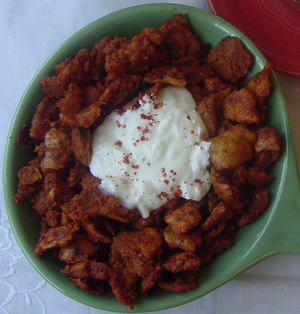African cuisine/ja: Difference between revisions
Created page with "=== 麺料理 === * Inyama yenhloko/ja" |
No edit summary |
||
| (13 intermediate revisions by the same user not shown) | |||
| Line 103: | Line 103: | ||
* [[Inyama yenhloko/ja]] | * [[Inyama yenhloko/ja]] | ||
=== 国々 === | |||
== | * [[Botswana cuisine/ja|ボツナワ料理]] | ||
* [[Botswana cuisine]] | * [[Cuisine of Eswatini/ja|エスワティニ料理]] | ||
* [[Cuisine of Eswatini]] | * [[Cuisine of Lesotho/ja|レソト料理]] | ||
* [[Cuisine of Lesotho]] | * [[Namibian cuisine/ja|ナミビア料理]] | ||
* [[Namibian cuisine]] | * [[South African cuisine/ja|南アフリカ料理]] | ||
* [[South African cuisine]] | * [[Zimbabwe cuisine/ja|ジンバブエ料理]] | ||
* [[Zimbabwe cuisine]] | * [[Mozambican cuisine/ja|モザンビーク料理]] | ||
* [[Mozambican cuisine]] | |||
==西アフリカ{{Anchor|West Africa}}== | |||
==West Africa== | {{Main/ja|West African cuisine/ja}} | ||
{{Main|West African cuisine}} | [[File:Mafe SN.JPG|thumb|[[:en:Senegal|セネガル]]人料理人によって調理された西アフリカの[[maafe/ja|マフェ]]、またはピーナッツシチュー]] | ||
[[File:Mafe SN.JPG|thumb| | |||
典型的な[[:en:West Africa|西アフリカ]]の食事は、[[starch/ja|でんぷん質]]の食材で作られ、肉、魚、様々なスパイスやハーブを含むことがある。[[fufu/ja|フフ]]、[[Banku (dish)/ja|バンクー]]、[[kenkey/ja|ケンキー]]([[:en:Ghana|ガーナ]]発祥)、フォウトゥ、[[couscous/ja|クスクス]]、トー、[[garri/ja|ガリ]]など、様々な主食がこの地域全体で食されており、これらはスープやシチューと共に供される。フフはしばしば[[yam (vegetable)/ja|ヤムイモ]]、[[Xanthosoma/ja|タロイモ]]、[[cassava/ja|キャッサバ]]などの[[root vegetable/ja|デンプン質根菜]]から作られるが、キビ、ソルガム、プランテンなどの穀物からも作られる。 | |||
[[File:Jollof rice.jpg|thumb|[[Jollof rice/ja|ジョロフライス]]は西アフリカ全域で人気のある料理である。]] | |||
[[File:Jollof rice.jpg|thumb|[[Jollof rice]] | 主食となる穀物やでんぷん質は地域や民族グループによって異なるが、トウモロコシは安価で、かさが増え、非常に好まれる美しい白い最終製品ができるため、大きな地位を占めている。バンクーとケンキーはトウモロコシ粉の主食であり、ガリは乾燥させたすりおろしたキャッサバから作られる。米料理もこの地域、特に内陸の乾燥した[[:en:Sahel|サヘル]]地帯で広く食べられている。これには、[[:en:Senegal|セネガル]]料理の[[thieboudienne/ja|チェブジェン]]([[Thieboudienne/ja|ベナチン]]としても知られる)や、アラブの[[kabsah/ja|カブサ]]に似たパン西アフリカの米料理である[[Jollof rice/ja|ジョロフライス]]などがある。 | ||
[[:en:West African|西アフリカ]]原産の植物であるギニアペッパー([[Aframomum melegueta/ja|''Aframomum melegueta''、別名グレインズ・オブ・パラダイスまたはメレゲッタペッパー]])の種子は、スパイスとして使用され、中世には北アフリカの中継貿易商を通じてヨーロッパにまで届いた。ヨーロッパの影響を受ける数世紀前には、[[:en:West Africa|西アフリカ]]人は[[:en:Arab world|アラブ世界]]と貿易を行っており、[[cinnamon/ja|シナモン]]、[[clove/ja|クローブ]]、[[Mentha/ja|ミント]]などのスパイスは知られており、地元の調味料の一部となっていた。数世紀後、ポルトガル人、フランス人、イギリス人がこの地域の料理に影響を与えたが、その程度は限られていた。 | |||
[[:en:West Africa|西アフリカ]]の地元料理とレシピは、在来米(''[[Oryza glaberrima/ja|Oryza glaberrima]]'')、米、[[fonio/ja|フォニオ]]、キビ、ソルガム、[[Bambara groundnut/ja|バンバラピーナッツ]]や[[Hausa groundnut/ja|ハウサピーナッツ]]、[[black-eyed pea/ja|黒目豆]]、茶豆、そしてヤムイモ、[[cocoyam/ja|タロイモ]]、[[sweet potato/ja|サツマイモ]]、キャッサバなどの根菜といった食材とともに、地元の慣習や伝統に深く根ざしている。調理技術には、[[roasting/ja|ロースト]]、[[baking/ja|焼く]]、[[boiling/ja|煮る]]、[[frying/ja|揚げる]]、マッシュする、スパイスを加えるなどがある。様々な甘いものや風味豊かなものも作られる。 | |||
[[File:Kwlikwli.jpg|thumb|[[:en:Benin|ベナン]]で供される揚げピーナッツバターの輪、クルイクルイ]] | |||
[[File:Kwlikwli.jpg|thumb| | 西アフリカの調理技術は変化している。かつて[[:en:West Africa|西アフリカ]]人は肉をあまり食べず、在来の油(沿岸部では[[palm oil/ja|パーム油]]、サヘル地域では[[shea butter/ja|シアバター]])を使用していた。バオバブの葉や数多くの地元の青菜は、一年の特定の時期には日常的な主食であった。今日、食事は肉、塩、脂肪がはるかに多くなっている。多くの料理には魚と肉が組み合わされており、乾燥魚や発酵魚も含まれる。薄切りにして乾燥させた魚はしばしば油で揚げられ、時には唐辛子、玉ねぎ、トマト、様々なスパイス([[sumbala/ja|スームバラ]]など)、水で作ったソースで調理され、風味豊かなシチューとなる。 | ||
一部の地域では牛肉と羊肉が好まれ、ヤギ肉は主要な赤肉である。[[Suya/ja|スヤ]]は、ピーナッツやその他のスパイスで味付けされた人気のグリルスパイシーミート[[kebab/ja|ケバブ]]で、屋台で軽食や夕食として売られており、通常は牛肉または鶏肉で作られる。魚介類が豊富に用いられるのが一般的であり、前述のように、他の肉製品と混ぜられることもある。ホロホロ鳥と鶏の卵も好まれる。 | |||
飲み物に関しては、水は多くの西アフリカ諸国(特に乾燥地域)で非常に強い儀式的な意味を持っており、アフリカのホストがゲストに最初に提供するものであることが多い。[[Palm wine/ja|パームワイン]]も一般的な飲み物で、様々な種類の[[Arecaceae/ja|ヤシ]]の木の樹液を発酵させて作られ、通常は甘口(発酵が少なく、樹液の糖分が多く残っているもの)または辛口(長く発酵させ、より強く甘味が少ないもの)が売られている。ミレットビールももう一つの一般的な飲み物である(ミレットビールはバンツービールとしても知られ、麦芽キビから作られるアルコール飲料である)。 | |||
===国々=== | |||
=== | * [[Benin cuisine/ja|ベナン料理]] | ||
* [[Benin cuisine]] | * [[Burkinabé cuisine/ja|ブルキナファソ料理]] | ||
* [[Burkinabé cuisine]] | * [[Ghanaian cuisine/ja|ガーナ料理]] | ||
* [[Ghanaian cuisine]] | * [[Cuisine of Guinea-Bissau/ja|ギニアビサウ料理]] | ||
* [[Cuisine of Guinea-Bissau]] | * [[Cuisine of Guinea/ja|ギニア料理]] | ||
* [[Cuisine of Guinea]] | * [[Ivorian cuisine/ja|コートジボワール料理]] | ||
* [[Ivorian cuisine]] | * [[Liberian cuisine/ja|リベリア料理]] | ||
* [[Liberian cuisine]] | * [[Malian cuisine/ja|マリ料理]] | ||
* [[Malian cuisine]] | * [[Mauritanian cuisine/ja|モーリタニア料理]] | ||
* [[Mauritanian cuisine]] | * [[Nigerian cuisine/ja|ナイジェリア料理]] | ||
* [[Nigerian cuisine]] | * [[Cuisine of Niger/ja|ニジェール料理]] | ||
* [[Cuisine of Niger]] | * [[Cuisine of Saint Helena/ja|セントヘレナ料理]] | ||
* [[Cuisine of Saint Helena]] | * [[Senegalese cuisine/ja|セネガル料理]] | ||
* [[Senegalese cuisine]] | * [[Cuisine of Sierra Leone/ja|シエラレオネ料理]] | ||
* [[Cuisine of Sierra Leone]] | * [[Togolese cuisine/ja|トーゴ料理]] | ||
* [[Togolese cuisine]] | '''<big>注目すべき料理</big>''' | ||
'''<big> | |||
'''ビターリーフ・スープ''' | |||
''' | |||
ビターリーフ・スープの正確な起源は不明であるが、数百年前から調理され食されてきたことが知られている。この料理は伝統的に魚、肉(通常は牛肉)、ビターリーフ、パーム油、様々な香辛料と調味料で構成されている。エビやザリガニなどの甲殻類は、魚と一緒にビターリーフ・スープの調理によく使われる。ビターリーフの苦味のため、苦味を減らすためにビターリーフは徹底的に洗浄されてから他の材料と一緒に調理される。西アフリカ、特にナイジェリアで広く消費されており、イボ族に関連付けられており、イボ語で「オフェ・オヌグブ」と呼ばれている。 | |||
ビターリーフ自体は、学名で''Vernonia amygdalina''として知られており、[[サハラ以南アフリカ]]が原産である。苦味は植物に含まれるアルカロイドに由来する。 | |||
==関連項目== | ==関連項目== | ||
Latest revision as of 21:35, 9 July 2025
アフリカ料理は、アフリカ大陸の多様な文化に不可欠な部分であり、その長く複雑な歴史を反映している。アフリカ料理の進化は、先住民の生活と密接に絡み合っており、彼らの宗教的慣習、気候、地元の農業に影響を受けている。初期のアフリカ社会は主に狩猟採集民で構成されており、野生の果物、野菜、ナッツを採集し、動物を狩って生活を維持していた。大陸全体で農業が発展するにつれて、キビ、ソルガム、そして後にトウモロコシなどの作物の栽培を伴う定住生活への緩やかな移行があった。農業はまた、食生活の変化をもたらし、宗教によって異なる様々な料理の伝統の発展につながった。多くのアフリカの伝統料理は、植物や種子をベースにした食生活に基づいている。
アフリカの各地域は、地元の食材、植民地時代の歴史、貿易によって形成された独自の料理習慣を発展させてきた。例えば、西アフリカでは、米、キビ、豆が特徴的な料理で、魚、肉、葉物野菜を使ったスパイシーなシチューが添えられることが多い。唐辛子、ピーナッツ、パーム油の使用もこの地域では広範である。一方、中央アフリカ料理はよりシンプルで、キャッサバやプランテンなどのデンプン質の食品に大きく依存しており、ピーナッツや野菜で作られたソースと共に供されることが多い。東アフリカ、特にケニア、タンザニア、ウガンダなどの国々では、料理は先住民の農業慣行と、インドや中東との貿易ルートからの影響が組み合わされていることを反映している。トウモロコシ、豆、米などの主食が、ウガリ(トウモロコシベースのお粥)やスクマウィキ(コラードグリーンから作られた料理)と共に一般的に食されている。東アフリカの沿岸地域、特にスワヒリ海岸沿いでは、シーフードやカルダモンやクローブなどのスパイスで味付けされたカレーが特徴で、これはインドやアラブの貿易商からの直接的な影響である。南部アフリカ料理もまた、先住民の食材と植民地時代の影響が混ざり合っている。パップ(トウモロコシベースのお粥)、ビルトン(ソーセージの一種)などの料理は、南アフリカ、ボツワナ、ナミビアなどの国々で人気がある。この料理は、ジビエ肉、トウモロコシ、豆の使用、そして植民地時代に導入されたヨーロッパの影響が特徴である。伝統的に、様々なアフリカ料理は、食品を輸入することなく、植物と種子をベースにした食材を組み合わせて使用する。大陸の一部では、伝統的な食事に根菜類が豊富に含まれている。
アフリカは、適応、貿易、創意工夫の豊かな歴史を象徴している。地域差は著しいものの、地元の食材と伝統的な調理技術の使用は、大陸の料理のアイデンティティの中心であり続けている。中央アフリカ、東アフリカ、北アフリカ、南部アフリカ、西アフリカはそれぞれ、独特の料理、調理技術、消費方法を持っている。
歴史
アフリカ在来の料理のルーツは、青銅器時代より数千年前の北東アフリカに遡る。この地域では、初期の文明がオオムギやコムギなどの穀物の栽培を始めた。北アフリカの一部は肥沃な三日月地帯に含まれ、古代エジプト人によって定住型農業が営まれていた。ロバやヒツジなどの動物も家畜化され、これがアフリカの他の地域、特に西アフリカへの農業の伝播の始まりとなった。しかし、ほとんどの部族は依然として単純な狩猟採集の食生活を送っていた。
アラブ人探検家のレオ・アフリカヌスとイブン・バットゥータは、サハラ以南のアフリカを旅する中で出会ったアフリカの食べ物について記録を残している。ほとんどのヨーロッパ人旅行者は19世紀まで沿岸地域に留まっていた。彼らの日記にも食べ物や作物に関する詳細が記録されている。現在アフリカ料理の重要な一部となっているトウモロコシやジャガイモのような多くの主食は、アフリカがヨーロッパ人によって植民地化された後に導入されるまで一般的ではなかった。
アフリカ料理がカリブ海、ブラジル、アメリカのローカントリー料理、ルイジアナのケイジャン料理に与えた影響は、米料理やアフリカ・カリブ海のエフォ、ドゥカヌー、カラルーのような緑色のシチューに見られる。アフリカから導入された野菜のオクラは、ルイジアナの代表的なガンボやカロライナのアメリカ米栽培に使用されている。ローカントリーは西アフリカの米栽培技術の影響を受けており、多くの奴隷が西アフリカの米作地域出身であった。ローカントリー料理は現在でもその独特の米料理で知られている。
中央アフリカ
中央アフリカは、北のティベスティ山地から、広大な熱帯雨林が広がるコンゴ川流域、キヴ高地、そしてカタンガのサバンナまで広がっている。
この地域は、サハラ横断奴隷貿易を通じてスワヒリ人(バンツー、イエメン、オマーン、インドの文化が融合して発展した文化)の料理の影響を受けている。スワヒリ料理の影響は、マンダジ、ピラフライス、カチュンバリ、サンブサ、ククパカなどの料理に見られる。
中央アフリカ料理は、コンゴ王国やンドンゴ王国を介してポルトガルの影響も受けている。塩漬け魚は17世紀後半の貿易後に導入され、塩漬け魚を指すキコンゴ語のマカヤブは、ポルトガル語のバカリャウに由来する。
ポルトガルの料理の影響は、特にアンゴラ、サントメ、赤道ギニアで顕著である。中央アフリカは、その近接性から東アフリカ、西アフリカ、南部アフリカ地域の料理からも影響を受けている。例えば、バブテまたはボボティーは南部と、ニャマチョマは東部と、sauce gomboは西アフリカと共通している。
中央アフリカでは、ヤムイモ、キャッサバ、バナナやプランテン、サツマイモ、タロイモなど、様々な作物が栽培されている。これらの作物は中央アフリカの多くの人々の食生活において主食となっている。フフのようなデンプン質の食品は通常発酵させたキャッサバの根から作られるが、プランテン、トウモロコシ、ヤムイモでも作ることができる。フフは、グリルした肉、魚、シチュー、葉物野菜、ピメントと共にビュッフェ形式で供される。トマト、ピーマン、唐辛子、玉ねぎ、ピーナッツバターで調理したほうれん草シチューなど、他の料理を作る際には様々な地元の食材が使われる。東部中央アフリカはまた、ジャガイモがこの地域で容易に育つため、主要な食材の一つとしてジャガイモを使用するアフリカでも数少ない地域の一つである。
キャッサバの葉も調理された青菜として食される。ピーナッツシチューもまた、鶏肉、オクラ、ショウガ、その他のスパイスを含んで調理される。牛肉や鶏肉は人気の肉料理であるが、ジビエ肉であるワニ、ゾウ、アンテロープ、イボイノシシの肉を含む料理も時折供される。
国々
東アフリカ



東アフリカの料理は地域によって異なる。内陸のサバンナでは、牧畜民の伝統的な料理は特徴的で、一般的に肉製品は含まれない。牛、羊、豚、ヤギは通貨の一種であり、富の蓄えとみなされていた。それらは一般的に食用には供されない。
一部の地域では、伝統的な東アフリカ人は牛の乳と血を消費するが、肉はめったに消費しない。他の地域では、アフリカ人は様々な穀物や野菜を栽培する農民である。トウモロコシは、西アフリカや中央アフリカのフフの現地版である「ウガリ」の基本である。ウガリは肉やシチューと共に食されるデンプン料理である。ウガンダでは、マートケと呼ばれる蒸した緑色のバナナが多くの食事のデンプン質を補給する。
約1000年前、オマーンやイエメンの商人がスワヒリ海岸に定住した。中東の影響は、特に沿岸のスワヒリ料理に反映されている。ペルシャ様式でスパイスを加えて蒸したり調理したりした米。サフラン、クローブ、シナモン、その他のスパイス。そしてザクロジュースなどがある。
数世紀後、イギリス人とインド人がやって来て、インド風のスパイスの効いた野菜カレー、レンズ豆のスープ、チャパティ、そして様々な漬物などの食品をもたらし、それが様々な地元の料理に影響を与えた。この地域で使われる一般的な食材には、オレンジ、レモン、ライム、唐辛子、パプリカ、トウモロコシ、トマト、イチゴなどがある。
アフリカの角では、エリトリア料理とエチオピア料理の主要な伝統料理は、インジェラ(テフ、小麦、またはソルガムから作られた平たいパン)とヒルベット(主にレンズ豆とソラマメから作られた豆類のペースト)と共に供されるツェブヒス(シチュー)である。エリトリアとエチオピアの料理(特に北半分)は、両国の共通の歴史を考えると、非常によく似ている。
エリトリアとエチオピアの食習慣は地域によって異なる。高地では、インジェラが主食であり、ティグリニャ人の間で毎日食べられている。インジェラはテフ、小麦、大麦、ソルガム、またはトウモロコシで作られ、スポンジ状のやや酸味のあるパンケーキに似ている。食事の際、食事をする人は通常、低い食卓の中央に置かれた大きなトレイから食べ物を共有する。このトレイには多くのインジェラが重ねられ、様々なスパイシーなシチューが乗せられる。食事をする人は、目の前のインジェラの区画をちぎり、シチューに浸して食べる。
低地では、主な料理はアケレットである。これは小麦粉の生地から作られたお粥のような料理である。おたまで上部をすくい取り、そこにベルベレとバターソースを入れ、牛乳やヨーグルトで囲む。少量の生地をちぎり、ソースをすくって食べる。

最もよく知られているエチオピア/エリトリア料理は、様々な野菜や肉のサイドディッシュとメイン料理で構成され、通常は厚いワット、つまりシチューが、テフ粉で作られた大きなサワードウのフラットブレッドであるインジェラの上に盛られる。道具は使わず、インジェラを使ってメイン料理やサイドディッシュをすくい取って食べる。
ティフロは焙煎した大麦粉から作られ、アムハラ、アガメ、アウラエロ(ティグレ)で非常に人気がある。伝統的なエチオピア料理では、豚肉やあらゆる種類の甲殻類は、ユダヤ教とエチオピア正教で禁じられているため、使用されない。また、テーブル中央の同じ皿から複数人で食べるのも非常に一般的である。

ソマリア料理は地域によって異なり、多様な料理文化が融合したエキゾチックな混合物で構成されている。これはソマリアの豊かな貿易と商業の伝統の産物である。多様性にもかかわらず、様々な地域料理を統合する一つの共通点がある。それは、すべての食べ物がハラールで供されることである。したがって、豚肉料理はなく、アルコール飲料は提供されず、自力で死んだものは食べられず、血は使用されない。Qaddoまたは昼食はしばしば手の込んだものである。
様々な種類のバリイス(米)があり、最も人気のあるのはバスマティで、通常はメインディッシュとして供される。クミン、カルダモン、クローブ、シナモン、セージなどのスパイスが、これらの様々な米料理に香りを添えるために使用される。ソマリア人は午後9時という遅い時間に夕食を供する。ラマダン期間中、夕食はしばしばタラウィーの祈りの後、時には午後11時という遅い時間に供される。
Xalwo(ハルウォ)またはハルヴァは、イードの祝祭や結婚披露宴などの特別な機会に供される人気の菓子である。砂糖、コーンスターチ、カルダモンパウダー、ナツメグパウダー、ギーから作られる。食感と風味を高めるためにピーナッツが加えられることもある。食後には、伝統的に乳香(ルバーン)または香(クーンシ)を使って家を香らせる。これらは香炉(ダブカアド)の中で準備される。
東アフリカ(ルワンダ、ブルンジ、南スーダン)における食料と栄養の安全保障は重大な問題である。この地域は1990年代以降、干ばつ、紛争、経済的不安定に悩まされてきた。現在の状況は、食料の入手可能性が低く、幼い子供たちの間で栄養失調のレベルが高いことが特徴である。この問題に対する提案された解決策は、地元での食料生産を増やすことである。これは、土壌の肥沃度と水管理を改善することによって農業生産性を高めることで達成され、農家が年間により多くの作物を栽培するのに役立つ。これはまた、地元の人々により多くの雇用機会を提供することによって、この地域の貧困を減らすのにも役立つだろう。
北アフリカ
北アフリカにおける食品ロスと廃棄に関する調査で、研究者たちはこの地域で食料の約30%が廃棄されており、人口増加に伴いこの割合はさらに増える可能性が高いことを発見した。この廃棄は、冷蔵施設や貯蔵施設の不足など、様々な理由で発生している。この問題を解決するため、人々は新しい料理や食品保存方法で創意工夫を凝らす必要があった。調べれば調べるほど、人々があらゆる植物の部位(葉、茎、花、果実、種子)を何らかの形で利用していることがわかった。また、動物のあらゆる食用部位も、脂肪から骨まで、出汁やスープを作るために利用していた。

北アフリカは地中海沿いに位置し、モロッコ、アルジェリア、リビア、チュニジア、エジプトなどいくつかの国々をその中に包含している。北アフリカ料理のルーツは、北アフリカの古代帝国、特にエジプトに遡ることができ、その国の多くの料理や料理の伝統はアフリカの古代にまで遡る。
数世紀にわたり、商人、旅行者、侵略者、移住者、移民がすべて北アフリカの料理に影響を与えてきた。1世紀のフェニキア人はソーセージをもたらし、カルタゴ人は小麦とその副産物であるセモリナを導入した。ベルベル人はセモリナをクスクス(主要な主食の一つ)に適用した。オリーブとオリーブオイルはローマ人が到来する前に導入された。
7世紀以降、アラブ人はサフラン、ナツメグ、シナモン、ショウガ、クローブなど様々なスパイスを導入し、北アフリカの食文化に貢献し影響を与えた。オスマン帝国は甘いペイストリーや他の焼き菓子をもたらし、新世界からはジャガイモ、トマト、ズッキーニ、唐辛子が北アフリカにもたらされた。
北アフリカのほとんどの国は、いくつかの類似した料理を持っており、時には名前が異なるだけでほぼ同じ料理(モロッコのタンジアとチュニジアのクーシャはどちらも本質的に同じ料理で、壺で調理され、公共のオーブンで一晩かけて調理される肉のシチューである)、時には食材や調理法がわずかに異なる場合もある。さらに、全く異なる2つの料理が同じ名前を共有することもある(例えば、タジン料理はモロッコではゆっくりと煮込んだシチューであるが、チュニジアのタジンは焼いたオムレツ/キッシュのような料理である)。モロッコの宮廷料理の洗練されたコクのある風味から、チュニジア料理の燃えるような辛い料理、そしてエジプトやアルジェリアのより質素でシンプルな料理まで、異なる国の調理法には顕著な違いがある。
南部アフリカ


南部アフリカ地域の料理(南アフリカという国と混同しないように)は、「レインボー料理」と呼ばれることがある。この地域の料理は、先住民のアフリカ社会、ヨーロッパ、そしてアジアの多くの文化が融合したものである。先住民のアフリカ料理を理解するためには、南部アフリカの様々な先住民を理解することが重要である。南部アフリカの先住民アフリカ人は、大まかに2つのグループといくつかのサブグループに分けられる。
最大のグループは、現在様々なサブグループ名、例えばンデベレ(北部と南部)、ショナ、ヴェンダ、ズールー、コサ、スワジ、ソト、ツワナ、ペディ、ツォンガなどで自らを識別しているバンツー語話者で構成されていた。彼らは約2,000年前にこの地域に到着し、作物栽培、畜産、鉄器製造の技術をもたらした。したがって、バンツー語話者は穀物作物を広範囲に栽培し、牛、羊、ヤギを飼育した。また、カボチャ、豆、葉物野菜も栽培し続けている。
より小さなグループは、この地域の原始的な住民であるコイサン族であった。一部の考古学者は、彼らが少なくとも1万年前からこの地域に住んでいたと考えている。コイサン族の子孫の多くは現在、南アフリカの人口に組み込まれている。コイサン族は元々狩猟採集民であった(バンツー語話者からは「サン」、ヨーロッパ人からは「ブッシュマン」として知られるようになった)。しかし、バンツー語話者の到来後、一部のコイサン族はバンツー語話者の牛の飼育を採用したが、作物は栽培しなかった。牛を飼育したコイサン族は自らを「コイコイ」と呼び、ヨーロッパ人からは「ホッテントット」として知られるようになった。

人々は、言い換えれば、ある程度、彼らが食べた食物の種類によって定義された。バンツー語話者は穀物、肉、牛乳、野菜の料理、発酵させた穀物や発酵乳製品を食べた。一方、コイコイ族は肉と牛乳を食べ、サン族は野生動物を狩り、野生の根菜や野菜を採集した。多くの点で、南アフリカの先住民家族の日常食は、彼らの先住民アフリカの祖先が食べた在来の食べ物に遡ることができる。コイサン族とバンツー族は伝統的に肉を焼いて食べ、また後で使うために肉を乾燥させた。
彼らの食生活の影響は、バーベキュー(南アフリカでは一般的にアフリカーンス語で「ブラーイ」と呼ばれる)とビルトン(乾燥保存肉)に対する南部アフリカ全体の普遍的な愛情に反映されている。伝統的なビールは南部アフリカの食生活に遍在しており、発酵によって食事にさらなる栄養が加えられた。訪問者に大量のビールを提供できることは、どの家族にとっても伝統的な義務であった。ビール醸造は女性によって行われ、植民地時代以前の南部アフリカにおける主婦の地位は、美味しいビールを醸造する彼女の腕前に大きく左右された。

牛乳は歴史的に南部アフリカの食生活において最も重要な要素の一つであった。牛は男性の最も重要な財産と見なされていた。結婚するためには、男性は花嫁の持参金として、将来の義理の親に牛を贈ることで補償しなければならなかった。結婚した男性は、妻と子供たちに十分な量の牛乳を提供し、牛、羊、ヤギを屠殺するたびに肉を提供することが期待されていた。冷蔵庫がなかったため、牛乳はほとんどが発酵してヨーグルトの一種になった。
家族の若い男性はしばしば村から遠く離れた「牛の牧場」で牛の世話をし、父親に代わってヨーグルトを着実に家に送った。今日、アフリカ系南アフリカ人の多くは、アメリカのバターミルク、ヨーグルト、サワークリームに匹敵する、スーパーマーケットで売られている酸っぱい乳製品を飲むことを楽しんでいる。 週末には「ブラーイ」を行い、食事は通常、「パップとヴライス」、つまりこの地域で歴史的に行われてきたトウモロコシ粥とグリルした肉で構成される。
基本的な食材には、魚介類、肉製品(野生の獲物を含む)、鶏肉、穀物、新鮮な果物、野菜が含まれる。果物には、リンゴ、ブドウ、マンゴー、バナナ、パパイヤ、アボカド、オレンジ、モモ、アンズなどがある。デザートは単に果物であることも多いが、イギリス料理とオランダ料理の両方に触発された、スティッキートフィープディングを思わせるマルバプディングのような、より西洋風のプリンもある。肉製品には、子羊肉、そして鹿肉、ダチョウ、インパラなどのジビエが含まれる。魚介類には、ザリガニ、エビ、マグロ、ムール貝、カキ、イカ、サバ、ロブスターが含まれる。また、多くのヨーロッパ風のビールを含む、数種類の伝統的および現代的なアルコール飲料がある。
麺料理
国々
西アフリカ
典型的な西アフリカの食事は、でんぷん質の食材で作られ、肉、魚、様々なスパイスやハーブを含むことがある。フフ、バンクー、ケンキー(ガーナ発祥)、フォウトゥ、クスクス、トー、ガリなど、様々な主食がこの地域全体で食されており、これらはスープやシチューと共に供される。フフはしばしばヤムイモ、タロイモ、キャッサバなどのデンプン質根菜から作られるが、キビ、ソルガム、プランテンなどの穀物からも作られる。

主食となる穀物やでんぷん質は地域や民族グループによって異なるが、トウモロコシは安価で、かさが増え、非常に好まれる美しい白い最終製品ができるため、大きな地位を占めている。バンクーとケンキーはトウモロコシ粉の主食であり、ガリは乾燥させたすりおろしたキャッサバから作られる。米料理もこの地域、特に内陸の乾燥したサヘル地帯で広く食べられている。これには、セネガル料理のチェブジェン(ベナチンとしても知られる)や、アラブのカブサに似たパン西アフリカの米料理であるジョロフライスなどがある。
西アフリカ原産の植物であるギニアペッパー(Aframomum melegueta、別名グレインズ・オブ・パラダイスまたはメレゲッタペッパー)の種子は、スパイスとして使用され、中世には北アフリカの中継貿易商を通じてヨーロッパにまで届いた。ヨーロッパの影響を受ける数世紀前には、西アフリカ人はアラブ世界と貿易を行っており、シナモン、クローブ、ミントなどのスパイスは知られており、地元の調味料の一部となっていた。数世紀後、ポルトガル人、フランス人、イギリス人がこの地域の料理に影響を与えたが、その程度は限られていた。
西アフリカの地元料理とレシピは、在来米(Oryza glaberrima)、米、フォニオ、キビ、ソルガム、バンバラピーナッツやハウサピーナッツ、黒目豆、茶豆、そしてヤムイモ、タロイモ、サツマイモ、キャッサバなどの根菜といった食材とともに、地元の慣習や伝統に深く根ざしている。調理技術には、ロースト、焼く、煮る、揚げる、マッシュする、スパイスを加えるなどがある。様々な甘いものや風味豊かなものも作られる。

西アフリカの調理技術は変化している。かつて西アフリカ人は肉をあまり食べず、在来の油(沿岸部ではパーム油、サヘル地域ではシアバター)を使用していた。バオバブの葉や数多くの地元の青菜は、一年の特定の時期には日常的な主食であった。今日、食事は肉、塩、脂肪がはるかに多くなっている。多くの料理には魚と肉が組み合わされており、乾燥魚や発酵魚も含まれる。薄切りにして乾燥させた魚はしばしば油で揚げられ、時には唐辛子、玉ねぎ、トマト、様々なスパイス(スームバラなど)、水で作ったソースで調理され、風味豊かなシチューとなる。
一部の地域では牛肉と羊肉が好まれ、ヤギ肉は主要な赤肉である。スヤは、ピーナッツやその他のスパイスで味付けされた人気のグリルスパイシーミートケバブで、屋台で軽食や夕食として売られており、通常は牛肉または鶏肉で作られる。魚介類が豊富に用いられるのが一般的であり、前述のように、他の肉製品と混ぜられることもある。ホロホロ鳥と鶏の卵も好まれる。
飲み物に関しては、水は多くの西アフリカ諸国(特に乾燥地域)で非常に強い儀式的な意味を持っており、アフリカのホストがゲストに最初に提供するものであることが多い。パームワインも一般的な飲み物で、様々な種類のヤシの木の樹液を発酵させて作られ、通常は甘口(発酵が少なく、樹液の糖分が多く残っているもの)または辛口(長く発酵させ、より強く甘味が少ないもの)が売られている。ミレットビールももう一つの一般的な飲み物である(ミレットビールはバンツービールとしても知られ、麦芽キビから作られるアルコール飲料である)。
国々
- ベナン料理
- ブルキナファソ料理
- ガーナ料理
- ギニアビサウ料理
- ギニア料理
- コートジボワール料理
- リベリア料理
- マリ料理
- モーリタニア料理
- ナイジェリア料理
- ニジェール料理
- セントヘレナ料理
- セネガル料理
- シエラレオネ料理
- トーゴ料理
注目すべき料理
ビターリーフ・スープ
ビターリーフ・スープの正確な起源は不明であるが、数百年前から調理され食されてきたことが知られている。この料理は伝統的に魚、肉(通常は牛肉)、ビターリーフ、パーム油、様々な香辛料と調味料で構成されている。エビやザリガニなどの甲殻類は、魚と一緒にビターリーフ・スープの調理によく使われる。ビターリーフの苦味のため、苦味を減らすためにビターリーフは徹底的に洗浄されてから他の材料と一緒に調理される。西アフリカ、特にナイジェリアで広く消費されており、イボ族に関連付けられており、イボ語で「オフェ・オヌグブ」と呼ばれている。
ビターリーフ自体は、学名でVernonia amygdalinaとして知られており、サハラ以南アフリカが原産である。苦味は植物に含まれるアルカロイドに由来する。
関連項目
| この記事は、クリエイティブ・コモンズ・表示・継承ライセンス3.0のもとで公表されたウィキペディアの項目African cuisine(16 June 2025, at 02:59編集記事参照)を翻訳して二次利用しています。 |